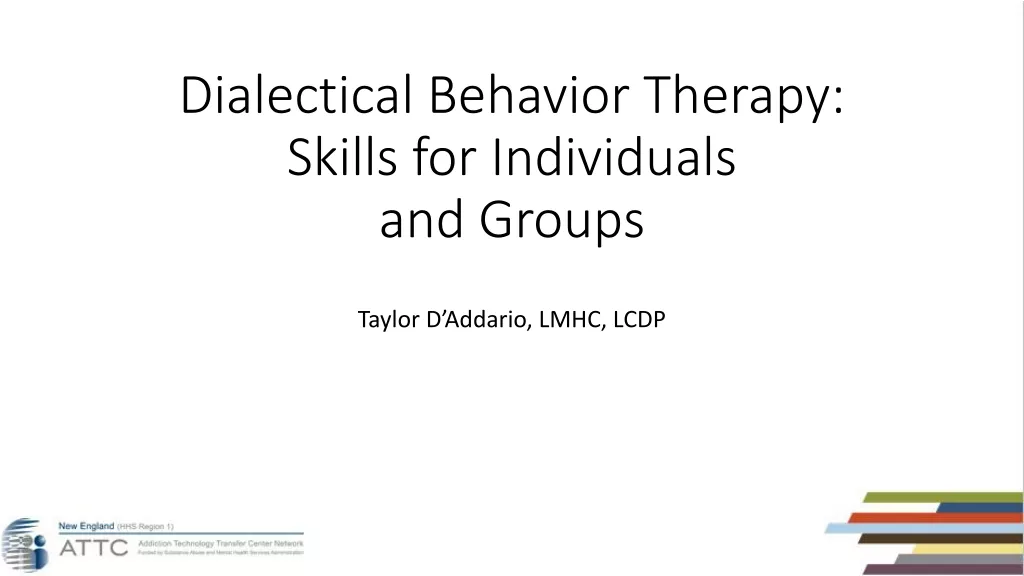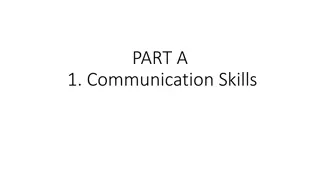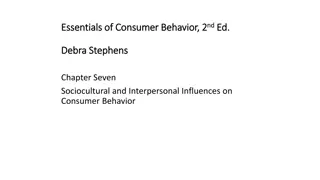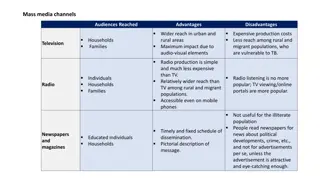Interpersonal Process
Explore the significance of interpersonal communication in addressing physical, social, and practical needs, the impact of technology and cultural diversity, and the importance of communication competence.
Download Presentation

Please find below an Image/Link to download the presentation.
The content on the website is provided AS IS for your information and personal use only. It may not be sold, licensed, or shared on other websites without obtaining consent from the author. Download presentation by click this link. If you encounter any issues during the download, it is possible that the publisher has removed the file from their server.
E N D
Presentation Transcript
CHAPTER 1 Interpersonal Process
Chapter Outline Why We Communicate The Communication Process The Nature of Interpersonal Communication Interpersonal Communication and Technology Interpersonal Communication and Cultural Diversity Comparison of Canadian and US Culture Communication Competence
Learning Outcomes You should be able to: identify examples of the physical, identity, social, and practical needs you attempt to satisfy by communicating; explain the interpersonal communication process: its transactional nature, governing principles, and characteristics; describe the degrees to which your communication is qualitatively impersonal and interpersonal; explain the advantages and drawbacks of various types of computer-mediated communication compared to face-to- face communication;
Learning Outcomes, contd define culture and co-culture, and explain the concept of degrees of intercultural communication; compare Canadian and American perceptions of violence, diversity, and the relative status of men and women and explain how these differences affect our interpretation of American interpersonal communication research findings; and identify principles of communication competence and characteristics of competent communicators.
Why We Communicate Physical needs Satisfying relationships can literally be a matter of life and death. Some examples: People who lack strong relationships run a greater risk of early death than people who are obese or exposed to air pollution. People with more supportive social networks are less susceptible to depression and cognitive decline. Divorced, separated, and widowed people are 5 to 10 times more likely to need psychiatric hospitalization than their happily married counterparts.
Why We Communicate, contd Pregnant women under stress and without supportive relationships have three times as many complications as pregnant women who suffer from the same stress, but have strong social support. Socially connected people s wounds heal faster. Socially isolated people are four times as susceptible to the common cold as those who have active social networks.
Why We Communicate, contd Identity needs Communication does more than enable us to survive. It is the major way we learn who we are. Deprived of communication with others, we would have no sense of identity.
Why We Communicate, contd Social needs Communication is the principal way relationships are created. Helps us to help and be helped by others, to feel included and worthwhile, to have fun and relax with others, and to exert influence and control in social situations. There is increasing evidence that active, meaningful face- to-face involvement with other people is essential to our happiness, resilience, well-being, and longevity.
Why We Communicate, contd Practical needs Communication is an essential part of effectiveness in a variety of daily situations. Abraham Maslow s categories of human needs: Physical Safety Social Self-esteem Self-actualization
The Communication Process, contd Insights from the transactional communication model Sending and receiving are usually simultaneous. Meanings exist in and among people. Environments affect communication. Noise affects communication. Channels make a difference.
The Communication Process, contd Communication principles Communication is transactional. Communication can be intentional or unintentional. Communication has a content and a relational dimension. Communication is irreversible. Communication is unrepeatable.
The Nature of Interpersonal Communication Quantitative and qualitative definitions Quantitative: Any interaction between two people. Dyad: Two people interacting. Qualitative: When people treat one another as unique individuals, regardless of the context in which the interaction occurs or the number of people involved. Characterized by uniqueness, irreplaceability, interdependence, disclosure of personal information, and intrinsic rewards.
The Nature of Interpersonal Communication, cont d Personal and impersonal communication: A matter of balance Most relationships fall somewhere between personal and impersonal. The blend of personal and impersonal communication can shift in various stages of a relationship.
The Nature of Interpersonal Communication, cont d Communication misconceptions Not all communication seeks understanding. More communication is not always better. Communication will not solve all problems. Effective communication is not a natural ability.
Interpersonal Communication and Technology Characteristics of computer-mediated communication Media richness/leanness describes the amount of non-verbal cues conveyed through a communication channel that add clarity to a message. Asynchronous communication occurs when there is a time gap between when the message was sent and when it is received, while synchronous communication occurs in real time. Permanence is how long the message endures.
Interpersonal Communication and Cultural Diversity Culture The language, values, beliefs, traditions, and customs people share and learn. In-groups Groups with which we identify. Out-groups Those we view as different. Co-culture A subgroup part of an encompassing culture.
Interpersonal Communication and Cultural Diversity, cont d Intercultural communication The process by which members of two or more cultures exchange messages in a manner that is influenced by their different cultural perceptions and symbol systems.
Comparison of Canadian and US Culture Attitudes toward violence Compared to the US, fewer Canadians perceive that they are surrounded by violence. Canadians are less likely to perceive violence as a normal part of every day life or a way of problem solving.
Comparison of Canadian and US Culture, cont d Acceptance of diversity Canadians consistently express more positive attitudes toward immigration. Canadians endorse the idea that immigrants have a good influence on their country. Canadians are more accepting of diversity in people s sexuality than Americans. The majority of Canadians want their communities to be fully accessible to people with disabilities and want Canada to be a leader on this front.
Comparison of Canadian and US Culture, cont d Relative status of men and women Although Canadians experience discrimination against women, they are less likely than Americans to endorse a view of patriarchal authority or a view that men are naturally superior to women. More Canadians support the view that common- law partners or same-sex partners are proper families.
Communication Competence What does it take to communicate better? is probably the most crucial question to ask as you read this book. Communication competence defined and described Balance between effective and appropriate communication.
Communication Competence, contd Motivation and open-mindedness are key Ethnocentrism Belief that one s own culture is superior to others. Prejudice Unfairly biased and intolerant attitude toward others who belong to an out-group. Stereotyping Exaggerated generalizations about a group.
Communication Competence, contd There is no single ideal or effective way to communicate There are many kinds of competent communication. Culture has significant influence on how we experience relationships.
Communication Competence, contd Competence is situational Competent behaviour varies from one situation and person to another. Competence requires mindfulness Mindfulness involves awareness of one s own behaviour and that of others. Competence can be learned Communication competence is, to a great degree, a set of skills that anyone can learn.
Communication Competence, contd Characteristics of competent communication A large repertoire of skills Adaptability Ability to perform skillfully Empathy and perspective taking Cognitive complexity The ability to construct a variety of different frameworks for viewing an issue. Self-monitoring The process of paying close attention to one s own behaviour and using these observations to shape the way one behaves.























